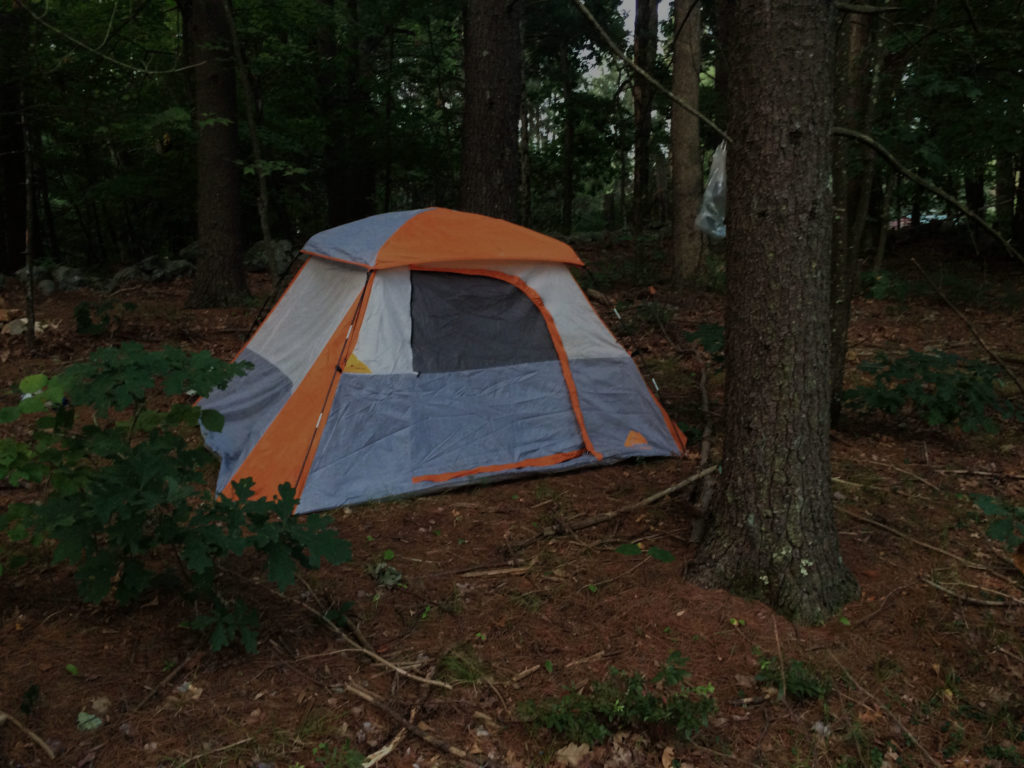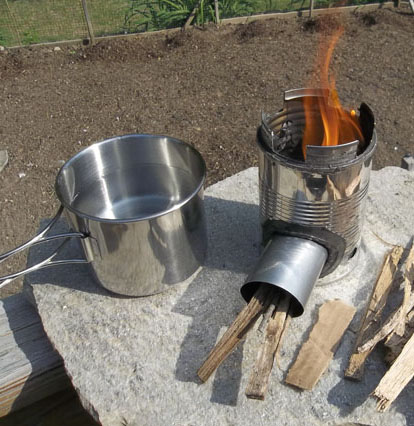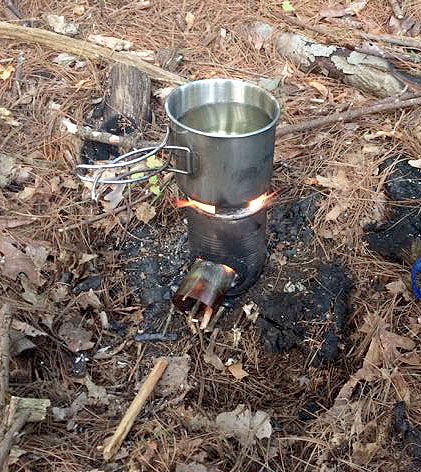Once again, I set out to spend a night in the woods testing the contents of my Bug Out Bag. Based on my experience with Test 1.0, I made some changes. This was a test to see if they were improvements or just changes.

Similar to Test 1.0, I had a day picked out well in advance, so I would not be able to cherry pick the weather conditions. The date was in August (a work schedule compromise) instead of early October, like Test 1.0. On the appointed day, I would head into the same woods shortly before evening, make my camp see how the gear (and myself) fared.
A change for Test 2.0 was that I would arrive with no water and have to find wild water. I would also have along a backpacker meal which needed water to prepare.
Changes Since Test 1.0
In Test 1.0, I had to make a shelter out of a tarp. It was October, so nights got chilly. I had to make an “all night” fire. Overall, the test was a success in that I made it through the night without major discomfort. If I had to get by with several such nights on my way to somewhere, I’d be okay.
Using my equipment to actually make an overnight camp did suggest a few tweaks. One, was to rig up better straps to hold my sleeping bag onto my pack. They worked much better. I had also packed various bits of like-use gear into their own ditty bags — one for water, one for fire, etc. This made getting to things much more efficient.

was cheap and sufficient.
Recognizing the limitations of tarps as shelters, this time I added a small popup tent to the cargo area of my truck. It’s a Walmart 2-person tent that weighs 5 lbs. All folded down, it’s about the size of two loaves of bread end-to-end. Tacticool? No. Last a lifetime? No. Sufficient for a multi-day Bug Out? Yes.

Since Test 1.0, I had also made up a hobo stove out of two nesting tin cans, with the air ports and feed hole as seen in many YouTube videos. I picked the outer can because it fit inside my stainless steel camp cup. My water bottle fit inside the hobo stove. Such nesting meant that the hobo stove took up little new space in the bag. I was eager to try it out in “the wild.”
With my hobo stove, I packed some camp cutlery. On another venture into the woods, I somehow managed to forget to pack a spoon or a fork. Eating hot reconstituted chili-mac off a knife did not appeal. That time, I whittled a crude spoon from a curved branch. It worked surprisingly well for a quick carving project. But, a real spoon would be so much better and not take up fading evening daylight to make.

Test 1.0 showed how un-satisfying a granola bar could be for a supper. I had only some trail mix and granola bars in my bag. Since then, I added a single-serving pouch of Mountain House dehydrated entree and a pack of instant oatmeal. They weigh very little but both require water to prepare.
The Day of the Test
Happily, the day arrived after a rain storm had moved through. Things were wet, but it was not raining. Like Test 1.0, events conspired to keep me from arriving early. I was a little earlier than last time, but not by a lot. I set out with my bag and grabbed up my little tent and headed into the woods.
I noticed that the forest floor had NO flat ground big enough for even my small tent. Lots of spots looked fairly flat until I started trying to clear a 6’ x 6’ space. Lumps, twists, slopes and brush just were everywhere. This was wild woods, not a State Park Camp Ground with idealized tenting spots. The sun was going down, so I settled for an area only slightly sloped and lighter on the debris. I cleared away the deadfall and rocks. The pop-up tent went up quickly. That was nice.
Since it was August, I did not need a fire to keep warm. That meant I did not need to gather an armload of wood for a night’s worth of campfire. I did, however, still need a good pile of twigs and small branches to feed my hobo stove. I needed to boil my filtered wild water to sanitize it and to rehydrate my meal. I’d need more cleaned water for my morning coffee too.
The search for water
With the tent set up and wood gathered, I looked for water. The swamp was closest. Since it had rained recently, there was some open water in the swamp, but it would require walking through the perimeter of soft muck to get to the water. I could tell I would sink into the mud. I did not want to deal with mucky boots and pant legs in my sparse-water environment.

Instead, I sought out the intermittent stream a bit farther north. This time, there was water in it — a little — mostly in still pools. The stream ran (slowly) in a deep little gully. The water level was quite shallow. Filling my Sawyer Mini’s supply bag from the stream was tediously slow. I did not want to ‘taint’ my one camp cup with wild water, so I used my hand to scoop some of the inch-deep water into the bag. That took longer than it should have. Squeezing the wild water into my vinyl bag took FAR more effort than expected. I’m surprised the seams did not burst. Sawyer’s bag is tough. Since evening was getting well on, I settled for a bit more than a half a gallon of filtered water and headed back to camp.
The hobo stove worked pretty well after I got enough good fuel. The deadfall on the ground was damp. It had rained recently. Dead pine twigs still on the tree were dry enough and burned eagerly. Dead pine branches a bit thinner than broom-handle diameter, could be broken without resorting to the saw. Splitting them into quarters with the fixed knife made them better stove-size fuel and exposed enough dry inner wood to burn well, despite the damp bark.

It was encouraging that a bundle of twigs and sticks produced enough heat to boil a cup and a half of water in under ten minutes. While the chicken and rice was reconstituting, I continued boiling water from the vinyl bag and transferring it to my Nalgene bottle. I pretended that I was going to press on to another camp location in the morning. Since I would not know if I’d come across another water source, I would want to take make water to take with me. I still had another quart or so in the vinyl bag that could travel too.
Supper was fantastic. When the evening air gets cool and damp and you’ve been tromping around in the woods with Bug Out Bag, and setting up a camp, a hot meal — even backpacker food — felt magically good.
Restless Night
The sleeping bag was sufficient for the weather, but I still felt cold. The ground was also much harder than expected. In Test 1.0, I only needed a pile of leaves beneath the sleeping bag for insulation. With a smaller area to cover, I had a bigger, fluffier pile of leaves and needles. That was fairly easy. Under the larger tent footprint, it was harder to pile up enough leaves to do the job. (without getting sticks in the pile too) The forest floor has a lot of sticks mixed in with the leaves. I did not have enough daylight left to devote to a big fluffy pile of leaves. As such, the “pile” under the tent was insufficient and matted down quickly. I woke up regularly with an arm or a leg going to sleep from being pinned against the hard ground.
It did not help that the tent sat on a slight incline (there were no Kansas-flat spots in those woods). That meant that each twist or turn inched me down toward the low end of the tent. Several times, I had to scoot back up the hill, only to repeat my wriggling descent.
All that waking up had a good side, though. I got regular samplings of the woods-at-night. Shortly before dawn, something was crunching through the woods. Its path was tangental to the tent, so I was not concerned about meeting some rabid raccoon, or something. (Side Note: Another minor change in gear was to bring along some hand-held protection.)
It was surprising how large an animal sounds in the dark woods. It could have been only a possum or a skunk, but it sounded like a moose. In the distance, beyond the swamp, a couple of coyotes tried to get a duet going, but gave up after a short while. Once the sky began to lighten from black to indigo, it was as if someone had suddenly turned on the Bird Noise sound track. They were all up and chattering at once.
Hobo Breakfast
I brought a big handful of my fuel twigs into the tent for the night. I didn’t want them wet with dew. They lit up eagerly. The cup of water seemed to take forever to boil. Pre-coffee minutes are twice as long as post-coffee minutes, it seems. While the instant coffee steeped, I boiled more water for the instant oatmeal and to top up my water bottle. I had packed a small vial of sugar, so it was not a breakfast of paper pulp. Yay for that.
Breaking Camp
I was pleased at how quickly I was able to break camp. The tent folded down and rolled up well. The various bits of gear went back into their respective ditty bags. Trash was quickly bagged up. All totaled, it probably took less time to break camp than it did to boil that first batch of coffee water. Getting the hobo stove cool enough to pack was the longest wait. Inside of 15 minutes, everything was on my back and the campsite looked as if no one had been there.
If this had been a real survival trek, I would have been on my way with a warm breakfast in my belly, a quart of water to tide me over until I found more wild water, and all the gear necessary to set up another quick camp.
Successes
I “survived” better than Test 1.0. Improvement is a success. The changes made as a result of lessons learned from the first test worked well. The sleeping bag straps did their job without hassle. The ditty bags kept the backpack from getting chaotic. Overall, the BOB gear made the night in the woods rather acceptable. The tent would have been gold in rainy weather; much more tolerable than just a tarp. It made setting up camp a very quick process (once you find a suitable spot).
If I had to press on for several days, the gear was good. Only my food supply would have come up short.
Lessons Learned
Sawyer Minis need to be primed: I missed that in the instructions. Mine was dry so it resisted any water passing through it for the longest time. Later, it flowed through quickly. Test your filter before you need it.
Have a Wild Water cup: The Sawyer supply bag doesn’t scoop well. Sawyer assumes you can dip it into deep water. It is harder to fill from shallow sources. It’s better to have things dedicated to the ‘dirty’ water to avoid cross-contamination. I used to have a collapsible cup made up of three concentric rings of hard plastic. While it worked, it was prone to collapse if bumped. Dipping in shallow streams guarantees a bump. Instead, I’m adding a one-piece silicone cup as my dirty-water scooper.

Wild Water might not be easy to get to: Water filter commercials always show big bodies of water. The reality might be a lot less handy. If the little stream had been dry, and the swamp was the only water, I would have had to improvise some sort of a way to get out to the open water without getting covered in muck (which I would not be able to wash off.) I figured that I could have cut several saplings with my Sven saw to lay down a sort of narrow boardwalk to get out to the open water. Tying my Wild Water Cup onto a stick would have been the safer way to dip out of the puddle and reduce the risk of falling in while bent way over to scoop.
The ground is hard and cold: My rubbery teenage years are long past. Even if I ignored the hardness, the cold ground sucks the heat out of your body. While I usually camp in the woods where there are leaves to pile up, I could be forced to camp where fluffy natural insulation is not available. So, I’ll be adding an inflatable minimalist sleeping pad. It’s not a matter of being “soft” so much as having insulation. I’m looking at the Klymit Inertia X. It rolls up quite small. The wife likes hers.
Backpacker Meals are pretty good: An entree is pretty lightweight and doesn’t take up much room. It might not be 5-star restaurant food, but in the woods, after hiking and making camp, it’s plenty good enough. Instant oatmeal is light too. I’ll be packing two or three days worth.
Adjustments to Make — In addition to the wild-water cup and inflatable pad, I will be adding some solid fuel tabs to my fire kit. I lucked out that the natural fuel for my hobo stove had a day to dry out. Trying to get a fire going in the rain, with wet wood, is really no fun. (Been there) The little Esbit fuel squares work pretty well. (My wife’s Car Bag has the folding Esbit stove.) I’ll add a four-pack of those in case I have to make a wet camp.
Confidence Building — One nice byproduct from these test-nights in the woods, is building confidence in my gear, as well as experience with it. I’m looking forward to testing the gear again this summer or fall. It would be very nice to feel so sure of my equipment that having to spend a night in the woods will be “ok” instead of “omg”.
Have you taken your Bug Out Bag into the woods to see how well it served you?
